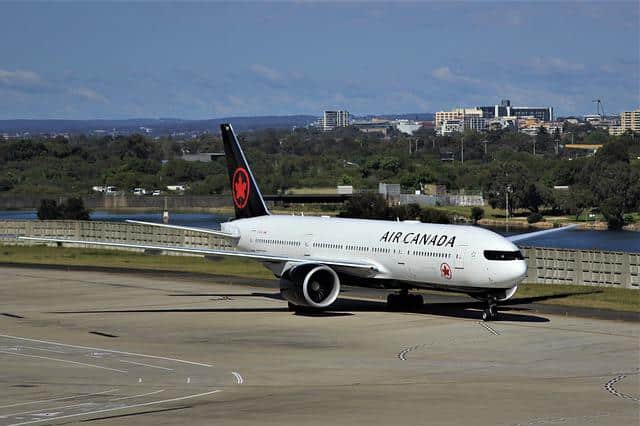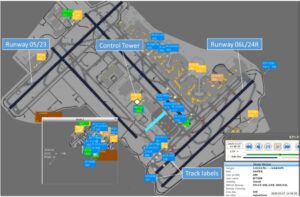Aerospace
Close Call: Air Canada Boeing 777 Began Take-Off Roll Behind E190 Rejected Take-Off

Air Canada’s Boeing 777 began its take off roll after the E-190 declined to take off.
On March 7, 2020, two planes were saved from a runway collision by the other plane’s captain, who took action and aborted the take off, saving many people’s lives. The Transportation Safety Board of Canada has updated the investigation.
On 07 March 2020, at 0948 Eastern Standard Time, the Air Canada Embraer ERJ 190-100 IGW (Embraer 190) aircraft (registration C-FMZW, serial number 19000124), operating as flight ACA1037 and carrying 83 passengers and 4 crew members, was conducting a takeoff from Runway 06L at Toronto/Lester B. Pearson International Airport, Ontario. Shortly after the Embraer 190 had begun its take-off roll, the Air Canada Boeing 777-333ER (Boeing 777) aircraft (registration C-FJZS, serial number 62400), operating as flight ACA606, was instructed to line up on Runway 06L. On board were 345 passengers and 14 crew members.
According to Investigation report As the Embraer 190 was accelerating on its take-off roll, it struck a bird. The flight crew initiated a rejected takeoff and made a radio call to report that they were rejecting the takeoff. Neither air traffic control nor the Boeing 777 flight crew heard this radio call because the Boeing 777 flight crew was reading back their take-off clearance on the same frequency.
As the Boeing 777 was accelerating on its take-off roll, the flight crew observed that the Embraer 190 was still on the runway and initiated a rejected takeoff. Both aircraft eventually exited the runway and returned to the terminal. There were no injuries. There was no damage to either aircraft.
Decision to issue the take-off clearance
At the time of the occurrence, the controller planned to coordinate the Boeing 777’s departure using pilot-applied visual departure separation behind the Embraer 190. He was using a rapid flow, or cadence, to be as expeditious as possible, in accordance with NAV CANADA’s MATS. He was highly experienced, was comfortable with the traffic level, and was managing the workload efficiently. The controller assessed this situation very quickly (in the span of only a few seconds), which was a normal practice. The controller made assessments based on his past experience, knowledge, and perceptions of the performance capabilities of both the Embraer 190 and the Boeing 777, including:
- perceiving the Embraer 190 at a speed at or near its rotation speed;
- perceiving the Embraer 190 in a position at or beyond a typical rotation point;
- timing the Boeing 777’s take-off clearance; and
- anticipating that the Embraer 190 would be airborne by the time the Boeing 777 flight crew read back their take-off clearance and started the take-off roll.
The controller’s expectation was very high that the Embraer 190 would depart at the controller’s assessed position and time. This expectation was reinforced by his knowledge that:
- high-speed rejected takeoffs are rare;
- aircraft do not conduct rejected takeoffs after rotation; and
- he had never in his career seen a rejected takeoff at such a high speed or from that point on the runway.
With this understanding, the monitoring stage and confirmation of action of the Embraer 190’s departure was effectively complete. Therefore, the controller transitioned to other duties, even though he did not actually see the Embraer 190 rotate. He concluded that the Embraer 190 was “rotating” based on all of the cues indicating that his assessment was correct.
The point at which the controller decided to issue the take-off clearance to the Boeing 777 was several seconds before the Embraer 190 was anticipated to be airborne. The controller’s situation assessment matched his mental model up to the point of the bird strike and the USiT. This decision was also influenced by guidance and procedures in the MATS, as well as the controller’s extensive experience.
Bird strike and Embraer 190’s rejected takeoff
When the Embraer 190 struck a bird on its take-off roll, the controller was issuing a take-off clearance to the Boeing 777. The Embraer 190 was travelling at 139 knots indicated airspeed (KIAS)—just below the calculated V1 speed of 146 KIAS—at the time. The captain of the Embraer 190 initiated a rejected takeoff and the first officer transmitted a radio call, per company procedures. This whole sequence of events took 5 seconds.
Undetected simultaneous transmissions
Simultaneous transmissions are a common hazard in aviation. They pose a threat and the risk of important communications going unheard increases when these transmission signals go undetected.
The radio transmissions from the Embraer 190 and the Boeing 777 were initiated within 0.1 seconds of each other and 0.6 and 0.7 seconds, respectively, after the controller had ended his radio transmission for the Boeing 777’s take-off clearance:
- At 0948:53.4, the first officer of the Embraer 190 initiated the radio call for the rejected takeoff. This transmission lasted 3.13 seconds.
- At 0948:53.5, the first officer of the Boeing 777 initiated the readback of the take-off clearance. This transmission lasted 3.225 seconds.
The timing of these radio calls indicates a full overlap of radio signals. As a result of this USiT, neither the controller nor the flight crew of the Boeing 777 were aware of the conflict because they did not know that the Embraer 190 was conducting a rejected takeoff.
Detecting the Embraer 190’s rejected takeoff
In this occurrence, the USiT meant that no aural cue was available to alert the controller or the Boeing 777 flight crew to the rejected takeoff. Unaware of the Embraer 190’s radio call to reject the takeoff, the controller carried on with his duties.
Once the Embraer 190 flight crew initiated the rejected takeoff, some visual cues were available to the controller:
- the Embraer 190 could be seen decelerating on the runway; and
- the speed values on the track label for the Embraer 190 on the controller working position (CWP) could be seen decreasing.
Because the controller was working from the north tower control position, he had to perform visual scans to monitor the thresholds of Runway 05 and Runway 06L, the departure end of Runway 06L, and the monitors at his CWP. To face either Runway 05 and the CWP or Runway 06L, he needed to turn 180°, and did so several times. This made it more difficult to visually monitor aircraft departing from Runway 06L because of the visual obstructions present when he was looking across the tower cab and out the window at Runway 06L.

Aerospace
When Ratan Tata was denied entry to the airfield at the Aero India show, he waited

During our visit to Aero India 2019, we had the unexpected opportunity to see Ratan Tata at the event, which was a thrilling moment for us. However, there was a surprising hiccup when the security staff didn’t allow him to enter due to a lack of a security pass.
Despite this, he remained calm and patiently waited for about 20 minutes until a member of the Tata team brought him the required pass, after which he calmly proceeded inside. It was a humbling sight, showcasing his composed demeanor even in such situations.
Ratan Tata ji is not only a renowned industrialist but also a trained pilot, holding a pilot’s license. In 2007, he became the first Indian civilian to fly the F-16 Falcon during the Aero India show in Bangalore—a proud moment for the nation.
His passion for aviation extended beyond flying, as he played a key role in shaping India’s aerospace industry. Under his leadership, Tata ventured into manufacturing and maintaining aerospace components while upholding its legacy of quality. Notably, Tata’s collaboration with Airbus to develop and manufacture the C295 aircraft is a testament to its growing influence in the sector.
-

 Aviation2 months ago
Aviation2 months agoMicrosoft Flight Simulator Raises $3 Million to Bring Back the An-225 Mriya
-

 Airlines2 months ago
Airlines2 months agoQantas Engineers Stage Walkout Over Cost of Living Concerns
-

 Airlines2 months ago
Airlines2 months agoQatar Citizens Can Travel to the United States Without a Visa
-

 Aviation2 months ago
Aviation2 months agoQatar Airways bans these new Electronic Devices on plane
-

 Airlines2 months ago
Airlines2 months agoJapan Airlines Rolls Out Free Domestic Flights to International Passengers
-

 Defence2 months ago
Defence2 months agoWhich Country Has the Largest Fleet of Fighter Aircraft?
-

 Airport2 months ago
Airport2 months agoWestern Sydney Airport Welcomes Its First Plane After 6 Years of construction
-

 Aviation2 months ago
Aviation2 months agoDid you know ? Once Boeing 747 carried 1088 passenger in 1991









